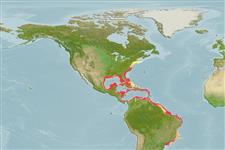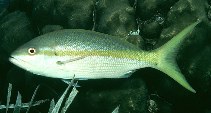Waarneming toevoegen in Fish Watcher
| Native range | All suitable habitat | Point map | Year 2050 |

|
| This map was computer-generated and has not yet been reviewed. |
| Ocyurus chrysurus AquaMaps Data sources: GBIF OBIS |
Uploaden van uw Foto's en video's
Pictures | Videos | Sounds | Stamps, coins, misc. | Google afbeeldingOcyurus chrysurus
Picture by Randall, J.E.
Pictures | Videos | Sounds | Stamps, coins, misc. | Google afbeeldingOcyurus chrysurus
Picture by Randall, J.E.
Dominican Republic country information
Common names:
Colirrubia
Occurrence: native
Salinity: marine
Abundance: | Ref:
Importance: | Ref:
Aquaculture: | Ref:
Regulations: | Ref:
Uses: no uses
Comments:
National Checklist:
Country Information: https://www.cia.gov/library/publications/resources/the-world-factbook/geos/dr.html
National Fisheries Authority: ttp://www.cep.unep.org/rep_dom/Rep_Dom.htm#SEA-PESQUERO
Occurrences: Occurrences Point map
Main Ref: Allen, G.R., 1985
National Database:
Occurrence: native
Salinity: marine
Abundance: | Ref:
Importance: | Ref:
Aquaculture: | Ref:
Regulations: | Ref:
Uses: no uses
Comments:
National Checklist:
Country Information: https://www.cia.gov/library/publications/resources/the-world-factbook/geos/dr.html
National Fisheries Authority: ttp://www.cep.unep.org/rep_dom/Rep_Dom.htm#SEA-PESQUERO
Occurrences: Occurrences Point map
Main Ref: Allen, G.R., 1985
National Database:
Common names from other countries
Classificatie / Names Lokale namen | Synoniemen | Catalog of Fishes(Genus, Soort(en)) | ITIS | CoL | WoRMS | Cloffa
> Eupercaria/misc (Various families in series Eupercaria) > Lutjanidae (Snappers) > Lutjaninae
Etymology: Ocyurus: Greek, okys = quick + Greek, oura = tail.
More on author: Bloch.
Etymology: Ocyurus: Greek, okys = quick + Greek, oura = tail.
More on author: Bloch.
Environment: milieu / climate zone / depth range / distribution range Ecologie
marien rifbewoner; diepte 0 - 180 m (Ref. 10795), usually 10 - 70 m (Ref. 55229). Subtropical; 42°N - 26°S, 98°W - 31°W (Ref. 55229)
Verspreiding Landen | FAO regio's | Ecosystemen | Voorkomen | Point map | Introducties | Faunafri
Western Atlantic: extending northward to Massachusetts, USA and Bermuda and southward to southeastern Brazil, in Gulf of Mexico and Antilles (Anderson, pers. comm.). Most common in the Bahamas, off south Florida and throughout the Caribbean. Lutjanus ambiguus (Poey, 1860), an intergeneric hybrid with Lutjanus synagris (Linnaeus) as demonstrated by Loftus (1992: Ref. 33006), followed by McEachran &. Fechhelm (2005: Ref. 78464).
Lengte bij maturiteit / Grootte / Gewicht / Leeftijd
Maturity: Lm 23.8, range 14 - 31 cm
Max length : 86.3 cm TL mannelijk / geslacht onbekend; (Ref. 9626); common length : 40.0 cm TL mannelijk / geslacht onbekend; (Ref. 55); max. gepubliceerd gewicht: 4.1 kg (Ref. 40637); max. gerapporteerde leeftijd: 14 Jaren (Ref. 3090)
Max length : 86.3 cm TL mannelijk / geslacht onbekend; (Ref. 9626); common length : 40.0 cm TL mannelijk / geslacht onbekend; (Ref. 55); max. gepubliceerd gewicht: 4.1 kg (Ref. 40637); max. gerapporteerde leeftijd: 14 Jaren (Ref. 3090)
Korte beschrijving Determinatiesleutels | Morfologie | Morfometrie
Dorsale stekels (totaal) : 10; Dorsale zachte stralen (totaal) : 12 - 14; Anale stekels: 3; Anale zachte stralen: 8 - 9. Head relatively small, lower jaw projecting slightly beyond the upper. Scale rows on back rising obliquely above lateral line. Back and upper sides blue to violet with scattered yellow spots. A prominent mid-lateral yellow band running from the snout to the caudal fin base. The lower sides and belly whitish with narrow reddish and yellow stripes; the dorsal and caudal fins yellow; the anal and pelvic fins whitish.
Adults inhabit coastal waters, mostly around coral reefs. Usually seen well above the bottom, frequently in aggregations. They feed on a combination of plankton and benthic animals including fishes, crustaceans, worms, gastropods and cephalopods, mainly at night (Ref. 9987). Young individuals are usually found over weed beds. They feed primarily on plankton (Ref. 9710). Spawning occurs throughout the year, with peaks at different times in different areas (Ref. 26938). Marketed fresh and frozen (Ref. 9987). Has been reared in captivity (Ref. 35420).
Levenscyclus en paargedrag Maturiteit | Voortplanting | Paaien | Eieren | Fecunditeit | Larven
Hoofdreferentie
Upload your references | Referenties | Coördinator | Medewerkers
Allen, G.R., 1985. FAO Species Catalogue. Vol. 6. Snappers of the world. An annotated and illustrated catalogue of lutjanid species known to date. FAO Fish. Synop. 125(6):208 p. Rome: FAO. (Ref. 55)
Status op de Rode Lijst van het IUCN (Ref. 130435: Version 2024-2)
Onvoldoende gegevens (DD) ; Date assessed: 10 October 2015
Gebruik door de mens
Visserij: commercieel; Aquacultuur: commercieel; sportvis: ja; Aquarium: Publieke aquaria
FAO(visserij: productie; publication : search) | FishSource | Sea Around Us
Meer informatie
Population dynamics
Groeiparameters
Max. ages / sizes
Length-weight rel.
Length-length rel.
Lengtefrequenties
Massaconversie
Rekrutering
Abundantie
Groeiparameters
Max. ages / sizes
Length-weight rel.
Length-length rel.
Lengtefrequenties
Massaconversie
Rekrutering
Abundantie
Life cycle
Voortplanting
Maturiteit
Fecunditeit
Paaien
Spawning aggregations
Eieren
Ontwikkeling van de eieren
Larven
Larvale populatiedynamiek
Voortplanting
Maturiteit
Fecunditeit
Paaien
Spawning aggregations
Eieren
Ontwikkeling van de eieren
Larven
Larvale populatiedynamiek
Physiology
Body composition
Nutrients
Zuurstofverbruik
Zwemtype
Zwemsnelheid
Visual pigments
Fish sound
Diseases & Parasites
Toxicity (LC50s)
Body composition
Nutrients
Zuurstofverbruik
Zwemtype
Zwemsnelheid
Visual pigments
Fish sound
Diseases & Parasites
Toxicity (LC50s)
Human related
Aquaculture systems
Aquacultuurprofielen
Kweeklijnen
Ciguatera cases
Stamps, coins, misc.
Aquaculture systems
Aquacultuurprofielen
Kweeklijnen
Ciguatera cases
Stamps, coins, misc.
Tools
Bio-Quiz | E-boek | Veldgids | Determinatiesleutels | Lengtefrequentie Tool | Levenscyclus tool | Verspreidingskaart | Classification Tree
| Catch-MSY |
Speciale rapporten
Bekijk gegevens voor het houden in een aquarium | Bekijk Fact Sheets voor de soort | Bekijk Aquacultuur Fact Sheets
Download XML
Internetbronnen
Aquatic Commons | BHL | Cloffa | Websites from users | Bekijk FishWatcher | CISTI | Catalog of Fishes(Genus, Soort(en)) | DiscoverLife | ECOTOX | Faunafri | Fishtrace | GenBank(genoom, nucleotide) | GloBI | GOBASE | | Google Books | Google Scholar | Google | IGFA World Record | MitoFish | Nationale databanken | Otolith Atlas of Taiwan Fishes | Publieke aquaria | PubMed | Reef Life Survey | RFE identificatie | Scirus | SeaLifeBase | Tree of Life | Wikipedia(ga naar, zoek) | World Records Freshwater Fishing | Zoological Record
Estimates based on models
Preferred temperature (Ref. 115969): 21.7 - 27.9, mean 25.9 (based on 650 cells).
Fylogenetische diversiteitsindex (Ref. 82804): PD50 = 1.0000 [Uniqueness, from 0.5 = low to 2.0 = high].
Bayesian length-weight: a=0.01514 (0.01348 - 0.01700), b=2.95 (2.92 - 2.98), in cm Total Length, based on LWR estimates for this species (Ref. 93245).
Trofisch niveau (Ref. 69278): 4.0 ±0.3 se; based on diet studies.
Weerstandsvermogen (Ref. 120179): Gemiddeld, minimale populatieverdubbelingstijd 1,4-4,4 jaar (K=0.10-0.16; tm=2; tmax=14).
Prior r = 0.63, 95% CL = 0.42 - 0.95, Based on 8 data-limited stock assessments.
Fishing Vulnerability (Ref. 59153): Moderate vulnerability (38 of 100).
Climate Vulnerability (Ref. 125649): Very high vulnerability (88 of 100).




